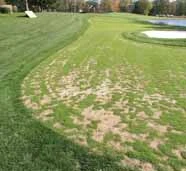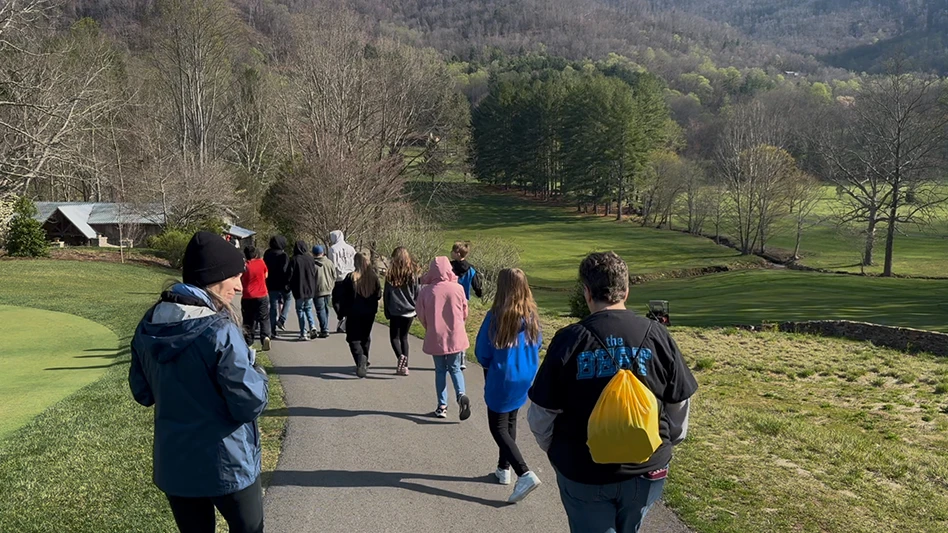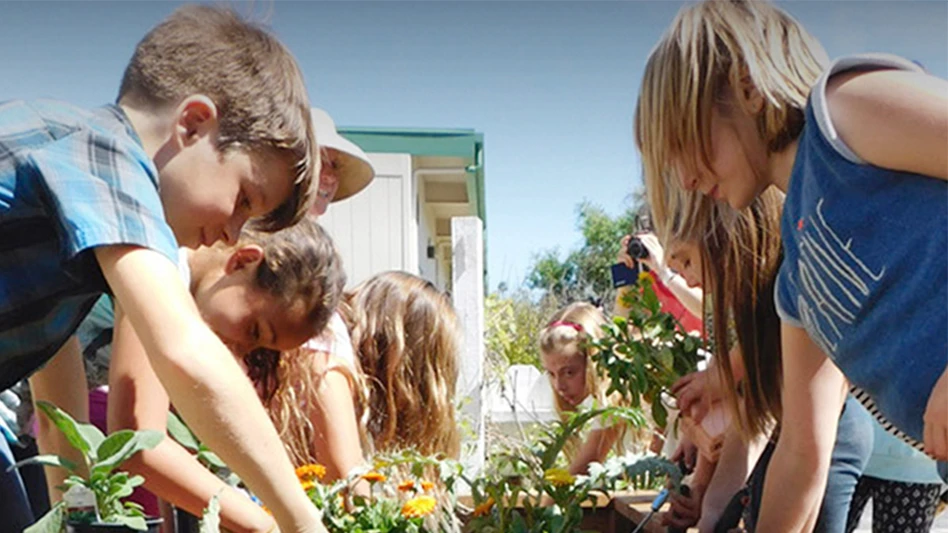
Waiting gets old. Just ask 17-year Wilmington CC superintendent Dan Pierson.
Severe turf injury occurred repeatedly at the Wilmington, Del., facility in the high-stress months of July and August during the late 1980s and early 1990s due to a pathogen that University of Maryland researcher Dr. Peter Dernoeden called the Woodmont Funk. The name arose because it was seen only at Rockville, Md.’s Woodmont CC and Wilmington CC.
The Wilmington facility chose fall 1994 – a year after Pierson replaced renowned superintendent Paul R. Latshaw at the 36-hole facility – to start gassing and regrassing the Robert Trent Jones-designed South Course with Crenshaw bentgrass. The club originally excluded fairways from the project even though USGA agronomist Stan Zontek suggested including them since the course would be closed. The grounds committee deemed it inappropriate to take the added risk but recognized replanting the fairways would be a distinct possibility in the future.
With the Woodmont Funk crisis averted, the club again considered replanting the fairways. A consensus developed to wait for Roundup Ready bentgrass, which seemed the next big thing. But regulatory concerns delayed approval year after year. In fact, Roundup Ready turf has yet to hit the market.
By 2004 the club decided it had waited long enough and committed to move ahead with a total renovation to bring the South Course up to current championship standards. (The second course is the 18-hole, Dick Wilson-designed North Course). The private facility hired architect Keith Foster in 2005 to develop a master plan.
In selecting grasses, Pierson called on his own replanting experiences, observations of what worked at other nearby layouts and consultations with Rutgers University turfgrass researcher Dr. James Murphy. He decided to use several Seed Research Oregon (SRO) varieties on the various parts of the South Course.
First opened in 1959, the 50-year-old layout still sported push-up greens slightly modified with aggregate material that “continue to give us a few problems today because they do not hold together well,” Pierson says. But the old putting surfaces also offered some advantages. They were very large, averaging almost 9,000 sq. ft. with excellent surface drainage and expansive cupping areas that allowed the maintenance staff to effectively disperse traffic and minimize wear.
In the end regrassing of the greens was done for two reasons; eliminate Poa contamination that had evolved since 1994 and improve grass variety to something potentially more cold-tolerant with an earlier spring green-up.
Additionally, as young trees matured at the originally open layout, foliage became a major issue that adversely affected turf health and diminished the many beautiful views. Tree removal is a tough sell to members. It helped that Oakmont CC undertook a major tree-removal project a few years earlier that received positive reviews. “Foster recommended we remove trees to improve the vistas of a wonderful and classic part of the Brandywine Valley,” Pierson says. “We removed about 600 on an ‘as appropriate’ basis as the project proceeded.”
Foster rebuilt all the bunkers to current standards and to better fit the landscape. He also rebuilt all tees, relocating some where necessary. He added yardage, proper angles, and new tees to create a fourth set throughout. The back tees now play at 7,350 yards.
To minimize downtime, builders redid the South Course in two phases. The first was the driving range, practice area, clubhouse grounds, a couple tees and the area exiting the 18th green. The bulk of the course work occurred in the second phase. The project took 18 months between 2006 and 2007. The South Course reopened June 18, 2008.
Pierson utilized Hendrix and Dail products, using methyl bromide to fumigate the greens. He knew the traditional fumigation material, which is being phased out for golf course use per government order, would work well.
Pierson chose Basamid to sterilize fairways. He says it may be the second-best product (after methyl bromide) to sterilize soil, but is tricky to use. The fine powder must be drop spread. Water activates the material (which must be irrigated a minimum of 1 inch immediately after application to activate the product) by turning it into a gas with the water acting as a barrier to keep it in the soil. Basamid works best on turf areas – bare soil is a different animal – needing only aggressive aerification to ensure gas penetration.
When a fine-finished grade is accomplished on a fairway with any contour, aerification is still required to ensure penetration. The application of substantial amounts of water can create wash outs. Working with Basamid in these areas resulted in some Poa annua seeds surviving and contaminating small amounts of turf. It also seemed to concentrate the chemical in basketball-sized spots resulting in no bentgrass germination in those areas, even after delaying seeding for up to three weeks. Repeat seedings were needed to fill in completely. But by the following June, the fairways were in excellent shape.
Following fumigation, Pierson settled on SRO’s Tyee as the new greens grass. According to SRO literature, Tyee creeping bentgrass reportedly performs well under temperature extremes that can be experienced in transition zone locales like Delaware. It maintains a dark, green color through the heat of summer and into the winter that provides an appealing contrast with other grasses in the fairway. It has improved resistance to brown patch and dollar spot – common transition zone problems – as well as copper spot, pythium blight and fusarium.
Like bentgrass siblings such as Penn A-1 and Penn A-4, Tyee requires extensive management for thatch control, including topdressing and verti-cutting. But the extra effort yields a superior putting surface, reduced syringing, less herbicides and reduced thatch production compared to other high-density bentgrasses.
Germination occurs in three to five days in temperate conditions and six to 10 days in colder daily temperatures. The first mowing is around 21 days and limited player use is possible in six to eight weeks.
“Tyee is reportedly, and seems to us, superior to other new varieties in terms of less bloating (meaning less scalping) and higher disease resistance,” Pierson says. “We cut our greens at 0.100 inch, weather permitting, and could likely go lower. Tyee established a little quicker than anything else we have tried. We are very optimistic it will continue to show excellent heat and drought tolerance.”
SRO’s 007 creeping bentgrass was the choice for the long-awaited fairway replanting. Seed Research developed it for improved dollar spot resistance, medium bright green leaf color, no cool-weather purple coloration, and a vigorous, uniform, moderately dense growth habit. It has rapid establishment and competitive growth against Poa annua all year long. It adapts well for low mowing on greens or for reduced fungicide use on fairways and tees. “It has a hardy color that contrasts well and provides definition to Tyee,” Pierson says. “It is aggressive like Tyee but with a broader leaf. Some courses are using it on their greens. We are mowing it at 0.380 inches in the fairways, but I’m sure we could cut it even lower.”
On the tees, Wilmington CC blended 007 with Quality Seeds’ Shark creeping bentgrass, a Murphy recommendation, to give the tees a color similar to the fairway. Pierson introduced a SRO ryegrass blend for the courtesy cut leading from the tee box and the step cut around the edges of the fairway.
One major challenge during the replanting process was a mini drought while seeding in 2007. The dry weather kindled some brief discussions of the possibility of replanting with less-water-thirsty Bermudagrass or zoysia grass, which might be possible in a transition zone area even as far north as Delaware. But Wilmington members preferred a grass that does not go into dormancy and turn brown in the fall.
The club also maintains a Patriot Bermudagrass practice tee it previously overseeded with ryegrass. Over time the ryegrass diminished the Bermudagrass base and renovation was required this season. The staff big-rolled the replacement Patriot sod and will try over-seeding with Riviera Bermudagrass seed to see if the club can keep the base longer.
“Bermudagrass might work here if you could get past its aesthetic shortcomings. It may get some additional consideration when we eventually replant the North Course,” Pierson says. With the 007 fairways in their third full season, Pierson would prefer to topdress at a rate of five to eight tons per acre as many as eight to 10 times per year to achieve optimum turf health, firming and smoothing the playing surface and reducing thatch. Weather and an aggressive club calendar have reduced the optimum number to a more realistic five or six times per season.
The putting surfaces are aerified and topdressed as often as possible during the season by applying sand first, and then aerifying on close pacing with Soil Relievers mounted with 5/16” x 12” solid tines, followed by a PlanetAir Turf Aerator spiking in a cross pattern. Light dragging and rolling is all that is required to return the surface to excellent playing condition almost immediately.” Total renovation cost ended up being less than $5 million.
Through negotiations with the construction contractor, Pierson accepted being general contractor. Taking on this role saved money but was time consuming. Locating, pricing, ordering, scheduling and coordinating took on new meaning as the project progressed. Suppliers delivered large quantities of materials from around the country. The logists were oftentimes dizzying. Meantime, Pierson was responsible for the second course, other club amenities and participating in the renovation itself.
“Almost immediately, our staff was needed for a great deal of support to the contractor as well as in many facets of the renovation that we had agreed from the beginning would be our responsibility. Bottom line, my advice to others would be to let the ‘general contractor’ title stay with the construction contractor. It is well worth the money.” GCI

Explore the August 2010 Issue
Check out more from this issue and find your next story to read.
Latest from Golf Course Industry
- The Aquatrols Company hires marketing manager
- Renovating Bredemus in West Texas
- Renovation starts at Okatie Creek GC at Sun City Hilton Head
- The Fittest Podcast in Turf: Episode 1
- New 6-hole course debuts in Oklahoma
- GCSAA announces Grassroots Ambassador Leadership Award recipients
- Reel Turf Techs: David Gummo
- PBI-Gordon promotes two to executive level





